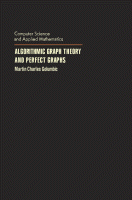Browse content
Table of contents
Actions for selected chapters
- Full text access
- Book chapterAbstract only
CHAPTER 1 - Graph Theoretic Foundations
Pages 1-21 - Book chapterAbstract only
CHAPTER 2 - The Design of Efficient Algorithms
Pages 22-50 - Book chapterAbstract only
CHAPTER 3 - Perfect Graphs
Pages 51-80 - Book chapterAbstract only
CHAPTER 4 - Triangulated Graphs
Pages 81-104 - Book chapterAbstract only
CHAPTER 5 - Comparability Graphs
Pages 105-148 - Book chapterAbstract only
CHAPTER 6 - Split Graphs
Pages 149-156 - Book chapterAbstract only
CHAPTER 7 - Permutation Graphs
Pages 157-170 - Book chapterAbstract only
CHAPTER 8 - Interval Graphs
Pages 171-202 - Book chapterAbstract only
CHAPTER 9 - Superperfect Graphs
Pages 203-218 - Book chapterAbstract only
CHAPTER 10 - Threshold Graphs
Pages 219-234 - Book chapterAbstract only
CHAPTER 11 - Not So Perfect Graphs
Pages 235-253 - Book chapterAbstract only
CHAPTER 12 - Perfect Gaussian Elimination
Pages 254-267 - Book chapterNo access
Appendix
Pages 269-275 - Book chapterNo access
Index
Pages 277-284 - Book chapterNo access
Computer Science and Applied Mathematics
Pages ibc1-ibc2
About the book
Description
Algorithmic Graph Theory and Perfect Graphs provides an introduction to graph theory through practical problems. This book presents the mathematical and algorithmic properties of special classes of perfect graphs. Organized into 12 chapters, this book begins with an overview of the graph theoretic notions and the algorithmic design. This text then examines the complexity analysis of computer algorithm and explains the differences between computability and computational complexity. Other chapters consider the parameters and properties of a perfect graph and explore the class of perfect graphs known as comparability graph or transitively orientable graphs. This book discusses as well the two characterizations of triangulated graphs, one algorithmic and the other graph theoretic. The final chapter deals with the method of performing Gaussian elimination on a sparse matrix wherein an arbitrary choice of pivots may result in the filling of some zero positions with nonzeros. This book is a valuable resource for mathematicians and computer scientists.
Algorithmic Graph Theory and Perfect Graphs provides an introduction to graph theory through practical problems. This book presents the mathematical and algorithmic properties of special classes of perfect graphs. Organized into 12 chapters, this book begins with an overview of the graph theoretic notions and the algorithmic design. This text then examines the complexity analysis of computer algorithm and explains the differences between computability and computational complexity. Other chapters consider the parameters and properties of a perfect graph and explore the class of perfect graphs known as comparability graph or transitively orientable graphs. This book discusses as well the two characterizations of triangulated graphs, one algorithmic and the other graph theoretic. The final chapter deals with the method of performing Gaussian elimination on a sparse matrix wherein an arbitrary choice of pivots may result in the filling of some zero positions with nonzeros. This book is a valuable resource for mathematicians and computer scientists.
Details
ISBN
978-0-12-289260-8
Language
English
Published
1980
Copyright
Copyright © 1980 Elsevier Inc. All rights reserved.
Imprint
Academic Press
